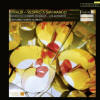Texte paru dans: / Appeared in:
*
International Record Review - (06-2011)
Pour
s'abonner / Subscription information

Ambronay
AMY029
Excerpt:
It is a cliché to say that Vivaldi wrote his sacred music in a highly operatic style, as did most other late-Baroque composers. Yet this is only true of the arias and duets, and even there only half true: the solo vocal writing is sometimes quite fond but nothing like as demanding as the display pieces Vivaldi wrote for the stage. Furthermore, unlike the operas, there is an abundance of first-rate choral writing throughout these psalms: some of it, in fact, written in quite decent fugal style. Alarcón points out that Monteverdi and Vivaldi were, unusually for Baroque church composers, not keyboard players and so did not have an organist’s instant facility for composing a ricercar, canon or fugue. He concludes that they had to look ah the harder to find a solution — ‘what might have been a limitation generated a wealth of ideas’. Some of the loveliest choral movements do not even attempt contrapuntal writing, such as the lilting and homophonic setting of the opening words of Beatus vir, which recurs throughout the psalm. Vivaldi the dramatist relishes the word-painting opportunities the texts of the psalms offer: for example, the tempestuous setting of ‘Implebit ruinas’ from the Dixit Dominus. Vivaldi the concerto writer can also be heard at times, notably in ‘Jucundus homo’ from Beatus vir, which is effectively a double concerto for soprano and violin.
The last-mentioned movement is flawlessly performed by violinist Flavio Losco and soprano Mariana Flores, who is a rising star of the Early Music world and the outstanding singer among a very strong cast. The other principal soprano Maria Soledad de la Rosa is scarcely less impressive; and Alarcón has apportioned them alternating movements in the big solo psalm Laudate pueri. Both have an agility and purity of tone that make them ideal Baroque stylists and happily they are the most prominent singers in the set. The other soloists are all more than acceptable, with the exception of mezzo Evelyn Ramirez, who has a large, old-fashioned voice that sits oddly with the rest of the ensemble. Most of the instrumental writing is for string ensemble, but organ and winds are given occasional opportunities for display. The Belgian period instrument orchestra Les Agrémens plays with strong attack and crisp ensemble. As its lithe and precise singing on this recording shows, the Choeur de Chambre de Namur is one of the most accomplished mixed-voice choirs specializing in Early Music. Having made several memorable recordings under Jean Tubéry, it was a shrewd move by the choir to ask Alarcón, one of the best and most exciting young Baroque conductors, to become its artistic director.
The recording is live, but fortunately none the worse for that. As well as Alarcón’s personal observations, there is a short historical essay by Lionel Desmeules, who also sings the antiphons on the recording.
Cliquez l'un ou l'autre
bouton pour découvrir bien d'autres critiques de CD
Click either button for many other reviews


